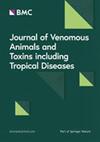棘蛛毒液中酰基多胺的抗菌活性及部分化学结构
IF 1.8
3区 医学
Q4 TOXICOLOGY
Journal of Venomous Animals and Toxins Including Tropical Diseases
Pub Date : 2022-03-18
DOI:10.1590/1678-9199-jvatitd-2021-0017
引用次数: 1
摘要
摘要背景:酰基多胺是蜘蛛毒液中存在的主要非肽化合物之一,在寻找具有抗菌作用的新分子方面具有广阔的前景。方法:采用反相高效液相色谱法(RP-HPLC)对棘血蛛毒液进行分离,并采用液体生长抑制法测定各分离组分的抑菌活性。含酰基多胺(ApAn)的主要抗菌部分经两个附加层析步骤,用MALDI-TOF进行分析。收集感兴趣的组分,用于紫外光谱(UV)和ESI-MS/MS分析,以及最低抑制浓度(MIC)和溶血活性测定。结果:从毒中分离到5个分子量在614 ~ 756 Da之间的酰基多胺,命名为ApAn728、ApAn614a、ApAn614b、ApAn742和ApAn756。通过紫外吸收谱分析和ESI-MS/MS获得的断裂图谱表明,ApAn的发色团为酪氨酸基单元,末端多胺链与结构单元PA43或PA53一致。ApAn对大肠杆菌和金黄色葡萄球菌的MIC在128µM ~ 256µM之间,对小鼠红细胞无溶血作用。结论:所分析的蜘蛛酰基多胺的抗菌和非溶血特性可能与它们作为治疗药物的应用有关,并且鉴定出一种非常规的蜘蛛酰基多胺发色团表明蜘蛛酰基多胺具有更大的化学多样性。本文章由计算机程序翻译,如有差异,请以英文原文为准。
Antimicrobial activity and partial chemical structure of acylpolyamines isolated from the venom of the spider Acanthoscurria natalensis
Abstract Background: Acylpolyamines are one of the main non-peptide compounds present in spider venom and represent a promising alternative in the search for new molecules with antimicrobial action. Methods: The venom of Acanthoscurria natalensis spider was fractionated by reverse-phase liquid chromatography (RP-HPLC) and the antimicrobial activity of the fractions was tested using a liquid growth inhibition assay. The main antimicrobial fraction containing acylpolyamines (ApAn) was submitted to two additional chromatographic steps and analyzed by MALDI-TOF. Fractions of interest were accumulated for ultraviolet (UV) spectroscopy and ESI-MS/MS analysis and for minimum inhibitory concentration (MIC) and hemolytic activity determination. Results: Five acylpolyamines were isolated from the venom with molecular masses between 614 Da and 756 Da, being named ApAn728, ApAn614a, ApAn614b, ApAn742 and ApAn756. The analysis of UV absorption profile of each ApAn and the fragmentation pattern obtained by ESI-MS/MS suggested the presence of a tyrosyl unit as chromophore and a terminal polyamine chain consistent with structural units PA43 or PA53. ApAn presented MIC between 128 µM and 256 µM against Escherichia coli and Staphylococcus aureus, without causing hemolysis against mouse erythrocytes. Conclusion: The antimicrobial and non-hemolytic properties of the analyzed ApAn may be relevant for their application as possible therapeutic agents and the identification of an unconventional chromophore for spider acylpolyamines suggests an even greater chemical diversity.
求助全文
通过发布文献求助,成功后即可免费获取论文全文。
去求助
来源期刊
CiteScore
4.80
自引率
8.30%
发文量
39
审稿时长
6-12 weeks
期刊介绍:
Journal of Venomous Animals and Toxins including Tropical Diseases (JVATiTD) is a non-commercial academic open access publication dedicated to research on all aspects of toxinology, venomous animals and tropical diseases. Its interdisciplinary content includes original scientific articles covering research on toxins derived from animals, plants and microorganisms. Topics of interest include, but are not limited to:systematics and morphology of venomous animals;physiology, biochemistry, pharmacology and immunology of toxins;epidemiology, clinical aspects and treatment of envenoming by different animals, plants and microorganisms;development and evaluation of antivenoms and toxin-derivative products;epidemiology, clinical aspects and treatment of tropical diseases (caused by virus, bacteria, algae, fungi and parasites) including the neglected tropical diseases (NTDs) defined by the World Health Organization.

 求助内容:
求助内容: 应助结果提醒方式:
应助结果提醒方式:


